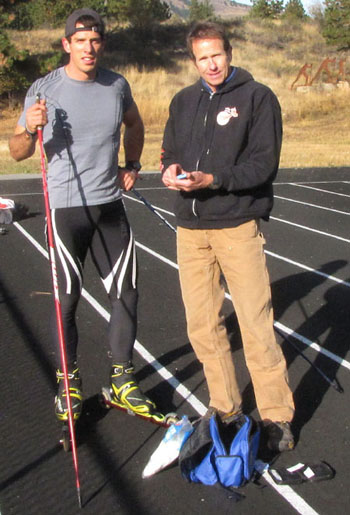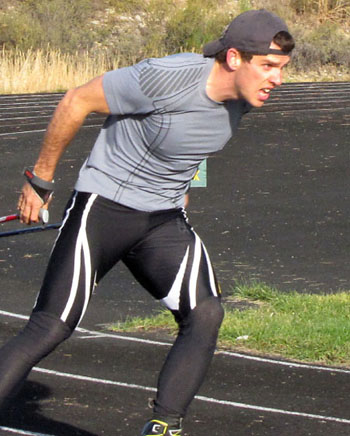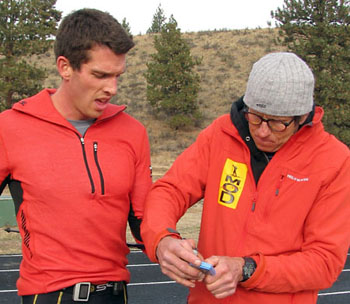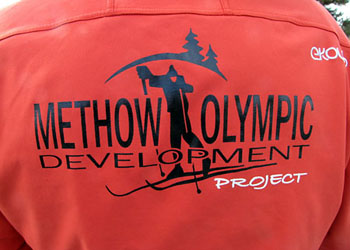home | internet service | web design | business directory | bulletin board | advertise | events calendar | contact | weather | cams

|
How Far Can He Go?  Skier Sam Naney and coach Scott Johnson during a recent early morning workout at the Liberty Bell High School track. Skier Sam Naney and coach Scott Johnson during a recent early morning workout at the Liberty Bell High School track.(scroll down for video) This is the story of two men, one with a burning desire to find out just how fine a Nordic skier he can be; the other the coach who is dedicated to helping him find out. Together the pair are the current version of the Methow Olympic Development Project (MOD). As the racing season approaches, Sam Naney is preparing 35-40 hours a week, sleeping 8-10 hours a night and consuming 4,000 to 5,000 calories a day. You might spot him working up a sweat on a long roller ski on a local road, zooming around the track at Liberty Bell High School, or running sprints up Water Tank Hill behind the high school dragging a tire attached to a harness around his waist. He’s taken five days off at most since April 1 and has none scheduled – just days with lighter workouts to recover from the more intense ones. “Sam may be the most athletically talented skier I’ve coached, but his endurance wasn’t what it needed to be,” says Scott Johnston, a top distance skier in the 1980s and early 1990s and former member of the U.S. Ski Team. He has a passion for helping young skiers reach their potential. “One of the problems with endurance sports is that they tend to attract ... ‘Type As’ who focus on one thing... Physiologically, he [Sam] looks more like a football player than a skier. He has a natural talent for athleticism but not endurance.” Thus Johnston has developed continually evolving challenges designed specifically for Naney. The two men meet for workouts three to four times a week. Johnston has Naney doing drills to build endurance about 20 hours a week. The rest is solitary training. “You spend a lot of time alone and a lot of time with your thoughts,” Johnston says. That solitary piece of what it takes to be a world-class athlete is exemplified by a handwritten sign posted on the wall of Johnston’s in-home gym, “You can’t coach desire.”  Sam Naney goes flat out on his roller skis as part of a slalom drill developed by Scott Johnston who has used it with all the athletes he's coached over the years. The goal is agility at high speed. "You're skiing in traffic and somebody is going to fall in front of you," says Johnston, explaining that you have to get out of the way and keep going. Sam Naney goes flat out on his roller skis as part of a slalom drill developed by Scott Johnston who has used it with all the athletes he's coached over the years. The goal is agility at high speed. "You're skiing in traffic and somebody is going to fall in front of you," says Johnston, explaining that you have to get out of the way and keep going.Naney has the desire. “We talk every day,” he says, adding, “I could go on for a very long time about the qualities of Scott. He is the most intelligent and critically minded coach I’ve ever met. He has a humility that I don’t see in other coaches... If he sees that training isn’t working, he’s never afraid of changing things. He has a reason for it... I’ve had my greatest gains as an athlete under him.” Naney, who grew up in the Methow Valley, says he wanted to ski as soon as he could walk. “I grew up at such a formative stage of the local ski team,” he says, adding, “I was consistently on the podium at the junior national championships.” But at age 27, he can make this unusual statement: “I’m still climbing in my ability and performance.” There are athletes who are maintaining their peak at his age, he explains, but he is still improving. “I don’t know how far I can go.” After three years of Johnston’s help, Sam Naney is about to find out. This racing season, which starts Thanksgiving weekend in West Yellowstone, Montana, he will enter skate and classic sprint events. He also will compete in distance races, but says it is his sprinting ability that will get him onto the podium or earn him a national championship as he skis the SuperTour, the national elite circuit, and the Canadian NorAm circuit. If he excels, Naney could earn a World Cup start spot with the U.S. Ski Team. “If I came out of the fall circuit as the top sprinter or top racer, I could go to Europe [in early 2012] and race some World Cup [events] there.” When Johnston moved to the Methow Valley with his wife, Midge Cross, in 2001, Naney was a junior at Liberty Bell High School. After graduation in 2002 he went on to Dartmouth College in Hanover, New Hampshire, which he selected both for its academics and the ski program. He earned a Bachelor of Arts degree in British history, but his post-ski career plan is to complete a doctorate in physical therapy, thus he is taking pre-medical courses online through the University of New England. “I don’t want to be one of those people who finish my ski career at 28 or 30 and not know what I’m doing with the rest of my life.”  Coach Johnston pricks Sam Naney's finger to test his blood lactate levels, a way of finding out how hard Sam's muscles are working. The results were considered right on target. Coach Johnston pricks Sam Naney's finger to test his blood lactate levels, a way of finding out how hard Sam's muscles are working. The results were considered right on target.Naney’s ski career suffered between college and 2008, when he came home to the Methow. “When I graduated from college [in 2006], I knew I wanted to give elite skiing a shot.” He moved to Montana but the program there lost funding. “I coached myself that entire year and just devastatingly overtrained. I was at the bottom of the barrel at the end of 2007.” During a phone conversation, Naney’s mother told him: “‘Call Scott.’” Johnston agreed to coach him. The 2008-2009 racing season was good. Naney won a SuperTour race in Wisconsin and had some top 10 finishes. The next season, he says he overtrained again and did not do so well. In 2010 his dryland training season was good, but then Naney – and his now fiancee, Alison Hanks, an ultra-runner – both got mononucleosis. “It was tough because at that point I didn’t know if I would race at all again that year,” Naney says. But by January of this year, having missed crucial training, he was competing again and did well in the national championships. Johnston says, “There is a developmental disconnect in American skiing.” There are thousands of kids in this country who are part of junior Nordic ski programs, they go off to college and ski in the National Collegiate Athletic Association programs and when they finish college their ski careers are over. “There’s only been one U.S. skier who’s gone through the collegiate program and stood on a World Cup podium,” Johnston says. That skier was Torin Koos, whom Johnston brought into the MOD program for one year. (Koos has returned to graduate school in Utah.)  The Methow Olympic Development Project logo adorns the back of coach Scott Johnston's jacket. The Methow Olympic Development Project logo adorns the back of coach Scott Johnston's jacket.The reason this country fails to produce champions, Johnston says, is the “cookbook approach”– coaches who put all athletes through the same training. “A lot of coaching is the feedback you get from the athlete... Everybody is an individual. I really believe that... The trouble a lot of athletes run into is the cookbook approach.” The exception, says Johnston, is Alaska Pacific University, which is not part of the NCAA. It has a unique program that provides high quality coaching and racing. Methow Valley siblings and former MOD skiers Sadie and Erik Bjornsen are both attending APU this year and they are two of the newest members of the U.S. Ski Team – Sadie the B team and Erik the D Team. “Sadie competed in the World Cup in 2011 and Erik was ranked seventh in the world as a junior skier,” Johnston says, without taking even a hint of credit. Naney is more loquacious. “I think its safe to say that the Bjornsens can attribute 90 percent of their gains to Scott.” Johnston said the ladder of events to be climbed by the world’s elite Nordic athletes is well-timed for Naney and the Bjornsens. The next world championships are in 2013. The next winter Olympics are in February 2014 in Sochi, a city by the Black Sea in southwestern Russia. The opening ceremony is a mere 800-plus days from now. However, on the eve of this racing season, Johnston says Naney’s main goal this year is to compete in the national championships the first week of January. And he thinks Naney may be selected to compete in some of the World Cup races. The travel involved in elite skiing makes it an expensive sport. Naney has several sponsors, including Hammer Nutrition, a maker of sports drinks, but he sleeps on plenty of couches when he travels. He also works throughout the year whenever he can, garnering income from multiple jobs – summer coaching for the junior ski team, washing windows, catering and serving legal papers. But he says he owes a great deal to numerous local individuals who make small donations every year and to supporters like Rita Kenny of Winthrop Mountain Sports, and Mark Waechter of Nordic Ultratune, who have provided him with equipment over the years. And don’t forget his coach, whom he calls “overwhelmingly generous.” Johnston’s Olympic Development Project is all volunteer time. He doesn’t charge a dime. And he’s not looking to grow his program. “My coaching style is tailored to the individual.” Two men committed to one goal: finding out how far Sam Naney can go in the world of elite Nordic skiing. To follow Naney’s training and racing season check www.methowolympicdevelopment.blogspot.com Race results will be posted at www.fasterskier.com.
|